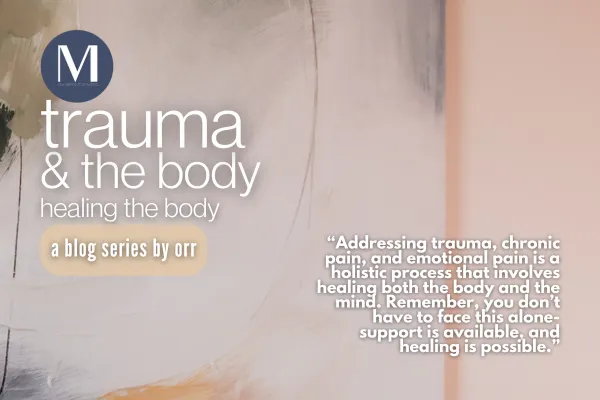the blog
A place for our team to share about topics they are passionate about, in hopes of allowing you to see and understand a bit more behind the faces on these pages.

Healing the Body: Approaches to Addressing Physical and Chronic Pain from Trauma
Healing the Body: Approaches to Addressing Physical and Chronic Pain from Trauma
Many people find that their physical pain is deeply connected to emotional experiences. Fortunately, there are some effective ways to support people and their experiences. Let’s explore a few approaches that might help you find relief.
1. Somatic Experiencing (SE)
Somatic Experiencing focuses on how trauma is stored in your body. It helps you reconnect with your physical sensations and understand how past experiences might be affecting you now. Somatic Experiencing encourages you to tune into your body’s responses and gently release tension. It’s like having a conversation with your body, listening to what it needs, and helping it return to a state of balance.
2. EMDR (Eye Movement Desensitization and Reprocessing)- you all know how much we love it!
EMDR is known for its effectiveness in dealing with trauma. It involves guided eye movements or other forms of bilateral stimulation to process and reframe traumatic memories. This method can be especially helpful for chronic pain linked to unresolved trauma, helping to lessen the emotional intensity and physical impact of these memories.
3. DBR (Deep Brain Reorienting)
Deep Brain Reorienting is a fascinating modality that focuses on recalibrating the brain's response to trauma. It works on the neural pathways that have been affected by trauma, aiming to help your brain reorganize and better manage stress responses. This technique can be particularly effective in addressing chronic pain by helping your brain process and release the tension related to traumatic experiences.
4. Integrative Approaches
Combining different therapies can often yield the best results. For instance, a blend of Somatic Experiencing and EMDR might work wonders for you. Adding practices like yoga or mindfulness meditation can further support your healing journey by relaxing both body and mind.
So…what you can do-
If you’re interested in these approaches, here are a few steps to get started:
Find a Therapist: Look for professionals who specialize in these therapies. It’s important to choose someone you feel comfortable with and who understands your needs.
Explore Techniques: Try different therapies to see what resonates with you. It may take some time to find what works best, and that’s perfectly okay.
Practice Self-Care: In addition to therapy, engage in self-care practices like regular exercise, a balanced diet, and enough sleep to support your healing.
Be Patient: Healing is a journey. Be patient with yourself and allow yourself to progress at your own pace.
As this is the final blog in our series on trauma and pain, I hope you've found these insights helpful. Addressing trauma, chronic pain, and emotional pain is a holistic process that involves healing both the body and the mind. Remember, you don’t have to face this alone- support is available, and healing is possible.
Office Location: 1200 Brock Street South, Whitby, ON. L1N 4L9
© Marquis Counselling & Consulting | ALL RIGHTS RESERVED | TERMS & CONDITIONS | PRIVACY POLICY
